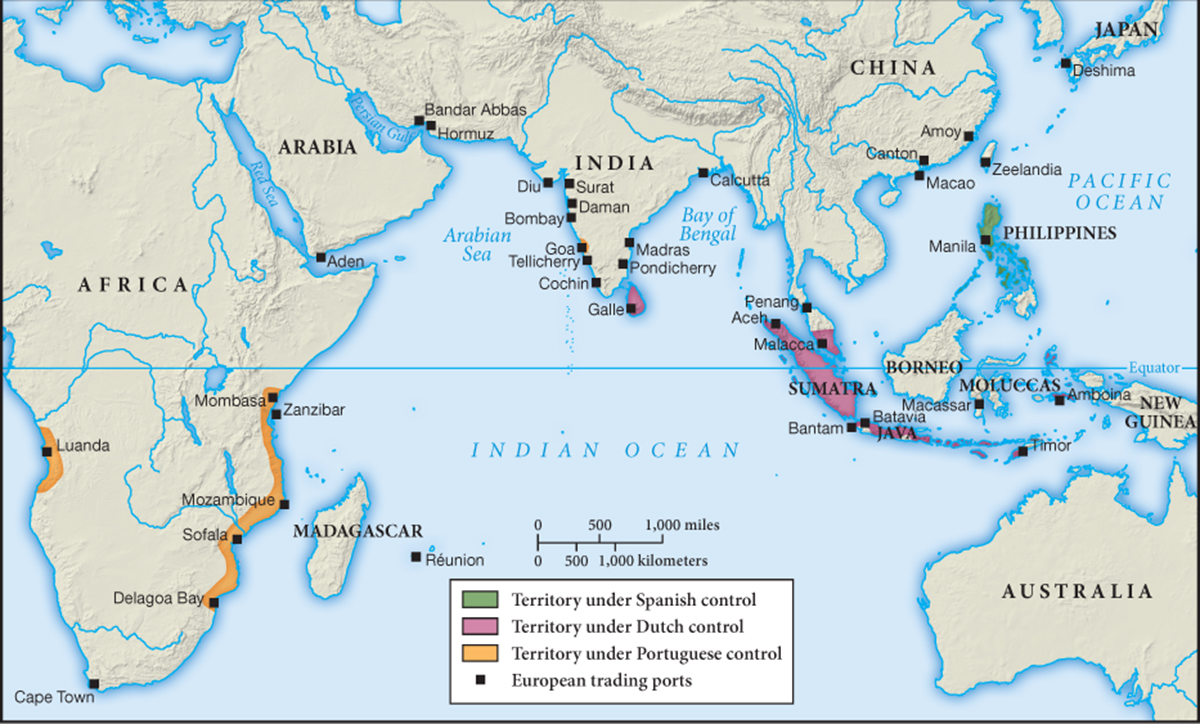Ways of the World with Sources
Printed Page 602
Ways of the World
Printed Page 500
Chapter Timeline
Europeans and Asian Commerce
Schoolchildren everywhere know that European empires in the Western Hemisphere grew out of an accident—Columbus’s unknowing encounter with the Americas—and that new colonial societies and new commercial connections across the Atlantic were the result. In Asia, it was a very different story. The voyage (1497–1499) of the Portuguese mariner Vasco da Gama, in which Europeans sailed to India for the first time, was certainly no accident. It was the outcome of a deliberate, systematic, century-long Portuguese effort to explore a sea route to the East, by creeping slowly down the West African coast, around the tip of South Africa, up the East African coast, and finally across the Indian Ocean to Calicut in southern India in 1498. There Europeans encountered an ancient and rich network of commerce that stretched from East Africa to China. They were certainly aware of the wealth of that commercial network, but largely ignorant of its workings.
What drove European involvement in the world of Asian commerce?
The most immediate motivation for this massive effort was the desire for tropical spices—cinnamon, nutmeg, mace, cloves, and, above all, pepper—which were widely used as condiments and preservatives and were sometimes regarded as aphrodisiacs. A fifteenth-century English book declared: “Pepper [from Java] is black and has a good smack, And every man doth buy it.”2 Other products of the East, such as Chinese silk, Indian cottons, rhubarb for medicinal purposes, emeralds, rubies, and sapphires, were also in great demand.
Underlying this growing interest in Asia was the more general recovery of European civilization following the disaster of the Black Death in the early fourteenth century. During the fifteenth century, Europe’s population was growing again, and its national monarchies—in Spain, Portugal, England, and France—were learning how to tax their subjects more effectively and to build substantial military forces equipped with gunpowder weapons. Its cities were growing too. Some of them—in England, the Netherlands, and northern Italy, for example—were becoming centers of international commerce, giving birth to economies based on market exchange, private ownership, and the accumulation of capital for further investment.
For many centuries, Eastern goods had trickled into the Mediterranean through the Middle East from the Indian Ocean commercial network. From the viewpoint of an increasingly dynamic Europe, several major problems accompanied this pattern of trade. First, of course, the source of supply for these much-desired goods lay solidly in Muslim hands. Most immediately, Muslim Egypt was the primary point of transfer into the Mediterranean basin and its European Christian customers. The Italian commercial city of Venice largely monopolized the European trade in Eastern goods, annually sending convoys of ships to Alexandria in Egypt. Venetians resented the Muslim monopoly on Indian Ocean trade, and other European powers disliked relying on Venice as well as on Muslims. Circumventing these monopolies was yet another impetus—both religious and political—for the Portuguese to attempt a sea route to India that bypassed both Venetian and Muslim intermediaries. In addition, many Europeans of the time were persuaded that a mysterious Christian monarch, known as Prester John, ruled somewhere in Asia or Africa. Joining with his mythical kingdom to continue the Crusades and combat a common Islamic enemy was likewise a goal of the Portuguese voyages.
A further problem for Europeans lay in paying for Eastern goods. Few products of an economically less developed Europe were attractive in Eastern markets. Thus Europeans were required to pay cash—gold or silver—for Asian spices or textiles. This persistent trade deficit contributed much to the intense desire for precious metals that attracted early modern European explorers, traders, and conquerors. Portuguese voyages along the West African coast, for example, were seeking direct access to African goldfields. The enormously rich silver deposits of Mexico and Bolivia provided at least a temporary solution to this persistent European problem.
First the Portuguese and then the Spanish, French, Dutch, and British found their way into the ancient Asian world of Indian Ocean commerce (see Map 14.1). How they behaved in that world and what they created there differed considerably among the various European countries, but collectively they contributed much to the new regime of globalized trade.

Map 14.1 Europeans in Asia in the Early Modern Era The early modern era witnessed only very limited territorial control by Europeans in Asia. Trade, rather than empire, was the chief concern of the Western newcomers, who were not, in any event, a serious military threat to major Asian states.
